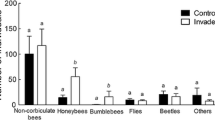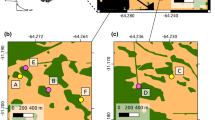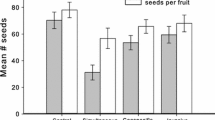Abstract
Showy invasive alien plants are often integrated in the diet of generalist pollinators and because of the lack of co-evolvement with the native plant community, a high amount of interspecific pollen transfer (IPT) can be expected. We investigated pollinator switching and magnitude plus distance of IPT between the alien aquatic Ludwigia grandiflora and the native Lythrum salicaria in both directions in uninvaded and invaded sites with a different relative abundance of L. grandiflora (% cover of the alien plant: no cover; low cover: <5%; high cover: 50–75%). A field experiment was conducted to include both pollinator interspecific movements and tracking of IPT, using fluorescent dye as a pollen analogue. Despite a substantial overlap in pollinators between L. grandiflora and the native L. salicaria, less than 10% of the observed flights were interspecific. Similar results were found in dye transfer patterns. The proportions of stigmas with conspecific dye were always higher than the proportions of stigmas with heterospecific dye for L grandiflora and L. salicaria. There were no differences in conspecific dye loads for L. salicaria between uninvaded and invaded sites. Conspecific pollen loss (native CPL) and heterospecific pollen deposition (alien HPD) were in general low and species-specific. The distance of HPD ranged respectively from 1.7 to 39 m and from 0.3 to 54.8 m in the low cover and high cover sites while CPL ranged respectively from 6.40 to 68.02 m and from 0.60 to 40.18 m in the low cover and high cover sites. We can conclude that, in this system, CPL and HPD will play a minor role in pollinator-mediated interaction. Furthermore, interspecific competition for pollinators will cover a larger distance than just neighboring individuals. Our results suggest the necessity to consider the combined effect of insect visitation, pollen deposition, relative alien abundance, distance and seed set when investigating pollinator-mediated interactions of invasive plants.




Similar content being viewed by others
References
Austerlitz F, Dick CW, Dutech C, Klein EK, Oddou-Muratorio S, Smouse PE, Sork VL (2004) Using genetic markers to estimate the pollen dispersal curve. Mol Ecol 13:937–954
Bartomeus I, Vilà M, Santamaria L (2008a) Contrasting effects of invasive plants in plant-pollinator networks. Oecologia 155:761–770
Bartomeus I, Bosch J, Vilà M (2008b) High invasive pollen transfer, yet low deposition on native stigmas in a Carpobrotus-invaded community. Ann Bot 102:417–424
Bjerknes A-L, Totland Ø, Hegland SJ, Nielsen A (2007) Do alien plant invasions really affect pollination success in native plant species? Biol Conserv 138:1–12
Brown BJ, Mitchell RJ (2001) Competition for pollination: effects of pollen of an invasive plant on seed set of a native congener. Oecologia 129:43–49
Chittka L, Schürkens S (2001) Successful invasion of a floral market. Nature 411:653
Colautti RI, White NA, Barrett SCH (2010) Variation of self-incompatibility with invasive populations of purple loosestrife (Lyhrum salicaria L.) from Eastern North America. Int J Plant Sci 171:158–166
Coussement K (2010) Plant-bestuiver interacties: invasieve Ludwigia grandiflora als study case. Master thesis, Vrije Universiteit Brussel, Brussels, Belgium, p 89
Cresswell JE, Bassom AP, Bell SA, Collines SJ, Kelly TB (1995) Predicted pollen dispersal by honey-bees and three species of bumble-bees foraging on oil-seed rape: a comparison of three models. Funct Ecol 9:829–841
DAISIE (2009) Handbook of alien species in Europe. Springer, Dordrecht
Dietzsch AC, Stanley DA, Stout JC (2011) Relative abundance of an invasive alien plant affects native pollination processes. Oecologia 167:469–479
Emer C, Vaughan IP, Hiscock S, Memmott J (2015) The impact of the invasive alien plant, Impatiens glandulifera, on pollen transfer networks. PLoS ONE 10(12):e0143532. doi:10.1371/journal.pone.0143532
EPPO (European and Mediterranean Plant Protection Organization) (2004) Ludwigia peploides and L. uruguayensis (=L. grandiflora). EPPO Alert List. 6 October 2004. European and Mediterranean Plant Protection. [online]. Available from http://www.eppo.org/QUARANTINE/plants/Ludwigia/LUDSS.htm
Esfeld K, Koch MA, van der Niet T, Seifan M, Thiv M (2009) Little interspecific pollen transfer despite overlap in pollinators between sympatric Aeonium (Crassulaceae) species pairs. Flora 204:709–717
Flanagan RJ, Mitchell RJ, Knutowski D, Karron JD (2009) Interspecific pollinator movements reduce pollen deposition and seed production in Mimulus ringens (Phrymaceae). Am J Bot 96:809–815
Gathmann A, Tscharntke T (2002) Foraging ranges of solitary bees. J Anim Ecol 71:757–764
Goulson D (1994) A model to predict the influence of insect flower constancy on interspecific competition in insect pollinated plants. J Theor Biol 168:309–314
Goulson D, Wright NP (1998) Flower constancy in the hoverflies Episyrphus balteatus (Degeer) and Syrphud ribesii (L.) (Syrphidae). Behav Ecol 9:213–219
Grant V (1994) Modes and origins of mechanical and ethological isolation in angiosperms. Proc Natl Acad Sci USA 91:3–10
Hardy OJ, Gonzalez-Martinez SC, Freville H, Boquien G, Mignot A, Colas B, Olivieri I (2004) Fine-scale genetic structure and gene dispersal in Centaurea corymbosa (Asteraceae) I. Pattern of pollen dispersal. J Evol Ecol 17:795–806
Holzschuh A, Dormann CF, Tscharntke T, Steffan-Dewenter I (2013) Mass-flowering crops enhance wild bee abundance. Oecologia 172:477–484
Jakobsson A, Padrón B, Traveset A (2008) Pollen transfer from invasive Carpobrotus spp. to natives—A study of pollinator behavior and reproduction success. Biol Conserv 141:136–145
Jakobsson A, Padrón B, Traveset A (2009) Competition for pollinators between invasive and native plants: effects of spatial scale of investigation (note). Ecoscience 16:138–141
Jakobsson A, Padrón B, Agren J (2015) Distance-dependent effects of invasive Lupinus polyphyllus on pollination and reproductive success of two native herbs. Basic Appl Ecol 16:120–127
Kearns CA, Inouye DW (1993) Techniques for pollination biologists. University Press of Colorado, Colorado
Kent M, Coker P (1992) Vegetation description and analysis—a practical approach. Wiley, New York
Kunin WE (1997) Population size and density effects in pollination: pollinator foraging and plant reproductive success in experimental arrays of Brassica kaber. J Ecol 85:22–234
Larson DL, Royer RA, Royer MR (2006) Insect visitation and pollen deposition in an invaded prairie plant community. Biol Conserv 130:148–159
Levin DA (1970) Assortative pollination in Lythrum. Am J Bot 57:1–5
Levine JM, Vilà M, D’Antonio CM, Dukes JS, Grigulis K, Lavorel S (2003) Mechanisms underlying the impacts of exotic plant invasions. Proc R Soc Lond B Biol Sci 270:775–781
Levy S (2011) The pollinator crisis: what’s best for bees. Nature 479:164–165
Lopezaraiza-Mikel ME, Hayes RB, Whalley MR, Memmott J (2007) The impact of an alien plant on a native plant-pollinator network: an experimental approach. Ecol Lett 10:539–550
Matrat R, Anras L, Vienne L, Hervochon F, Pineau C, Bastian S, et al. (2004) Gestion des plants exotiques envahissantesen cours d’eau et zones humides. (Gestion des plants exotisues envahissantes). Comité de pays de la Loire: 48 pp + annexes
McKinney AM (2010) Pollinator-mediated interactions between the invasive shrub Lonicera maacki and native herbs: the roles of shade, flowering phenology, spatial scale, and floral density. Dissertation, The Ohio State University, USA
Mitchell RJ (1993) Adaptive significance of Ipomopsis aggregata nectar production: observation and experiment in the field. Evolution 47:25–35
Mitchell RJ, Flanagan RJ, Brown BJ, Waser NM, Karron JD (2009) New frontiers in competition for pollination. Ann Bot 103:1403–1413
Moragues E, Traveset A (2005) Effect of Carpobrotus spp. on the pollination success of native plant species of the Balearic Islands. Biol Conserv 122:611–619
Morales CL, Traveset A (2008) Interspecific pollen transfer: magnitude, prevalence and consequences for plant fitness. Crit Rev Plant Sci 27:221–238
Morales CL, Traveset A (2009) A meta-analysis of impacts of alien vs. native plants on pollinator visitation and reproductive success of co-flowering native plants. Ecol Lett 12:716–728
Morris WM, Mangel M, Adler FR (1995) Mechanisms of pollen deposition by insect pollinators. Evol Ecol 9:304–317
Muchhala N, Thomson JD (2012) Interspecific competition in pollination systems: costs to male fitness via pollen misplacement. Funct Ecol 26:476–482
Nielsen C, Heimes C, Kollman J (2008) Little evidence for negative effects of an invasive alien plant on pollinator services. Biol Invasions 10:1353–1363
Okada M, Grewell BJ, Jasieniuk M (2009) Clonal spread of invasive Ludwigia hexapetala and L. grandiflora in freshwater wetlands of California. Aquat Bot 91:123–129
Rademaker MCJ, De Jong TJ, Klinkhamer PGL (1997) Pollen dynamics of bumble-bee visitation on Echium vulgare. Funct Ecol 11:554–563
Rathcke BJ (1983) Competition and facilitation among plants for pollination. In: Real LA (ed) Pollination Biology. Academic, Orlando, pp 305–329
Riedinger V, Mitesser O, Hovestadt T, Steffan-Dewenter I, Holzschuh A (2015) Annual dynamics of wild bee densities: attractiveness and productivity effects of oilseed rape. Ecology 96:1351–1360
Rodriguez LF (2006) Can invasive species facilitate native species? Evidence of how, when, and why these impacts occur. Biol Invasions 8:927–939
Sokal RR, Rohlf FJ (2003) Biometry: the principles and practice of statistics in biological research, 3rd edn.
Spigler RB, Chang S-M (2008) Effects of plant abundance on reproductive success in the biennial Sabatia angularis (Gentianaceae): spatial scale matters. J Ecol 96:323–333
Stiers I, Crohain N, Josens G, Triest L (2011) Impact of three aquatic invasive species on native plants and macroinvertebrates in temperate ponds. Biol Invasions 13:2715–2726
Stiers I, Coussment K, Triest L (2014) The invasive aquatic plant Ludwigia grandiflora affects pollinator visitants to a native plant at high abundances. Aquat Invasions 9:357–367
Takakura K-I, Matsumoto T, Nishida T, Nishida S (2011) Effective range of reproductive interference by an alien dandelion, Taraxacum officinale, on a native congener. J Plant Res 124:269–276
Totland Ø, Nielsen A, Bjerknes A-L, Ohlson M (2006) Effects of an exotic plant and habitat disturbance on pollinator visitation and reproduction in a boreal forest herb. Am J Bot 93:868–873
Van Geert A, Van Rossum F, Triest L (2010) Do linear landscape elements in farmland act as biological corridors for pollen dispersal? J Ecol 98:178–187
Van Rossum F (2009) Pollen dispersal and genetic variation in an early-successional forest herb in a peri-urban forest. Plant Biol 11:725–737
Van Rossum F, Stiers I, Van Geert A, Triest L, Hardy OJ (2011) Fluorescent dye particles as pollen analogues for measuring pollen dispersal in an insect-pollinated forest herb. Oecologia 165:663–674
Vilà M, Bartomeus I, Dietzsch A, Petanidou T, Steffan-Dewenter I, Stout JC, Tscheullin T (2009) Invasive plant integration into native plant-pollinator networks across Europe. Proc R Soc Lond B Biol Sci 276:3887–3893
Yang C-F, Gituru RW, Guo Y-H (2007) Reproductive isolation of two sympatric louseworts, Pedicularis rhinanthoides and Pedicuaris longiflora (Orobanchaceae): how does the same pollinator type avoid pollen transfer? Biol J Linn Soc 90:37–48
Acknowledgements
We thank K. Coussement for field and laboratory assistance, L. Brans, T. Glorieux, T. Sierens, R. Stiers and M. Vanderlinden for field assistance, Prof. B. Vanschoenwinkel and Dr. F. Van Rossum for their advice on statistical analyses and modeling of the dye dispersal curves and the laboratory of Cellular Genetics (VUB) for microscope disposal. We thank the associate editor and three anonymous reviewers for their valuable suggestions on a previous version of the paper. This research was part of the project ‘ALIEN IMPACT’ financed by the Belgian Science Policy, contract number SD/BD/01A and the Vrije Universiteit Brussel (BAS 42).
Author information
Authors and Affiliations
Corresponding author
Electronic supplementary material
Below is the link to the electronic supplementary material.
Rights and permissions
About this article
Cite this article
Stiers, I., Triest, L. Low interspecific pollen transfer between invasive aquatic Ludwigia grandiflora and native co-flowering plants. Biol Invasions 19, 2913–2925 (2017). https://doi.org/10.1007/s10530-017-1494-1
Received:
Accepted:
Published:
Issue Date:
DOI: https://doi.org/10.1007/s10530-017-1494-1




